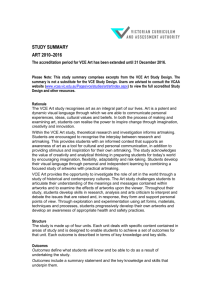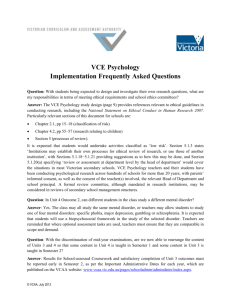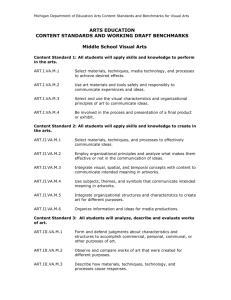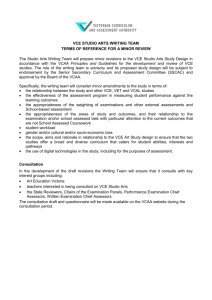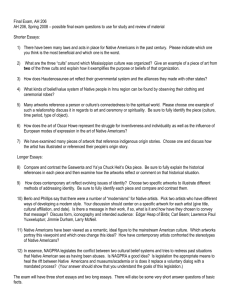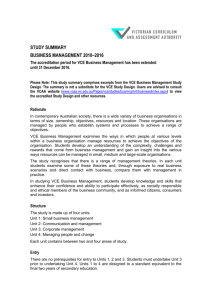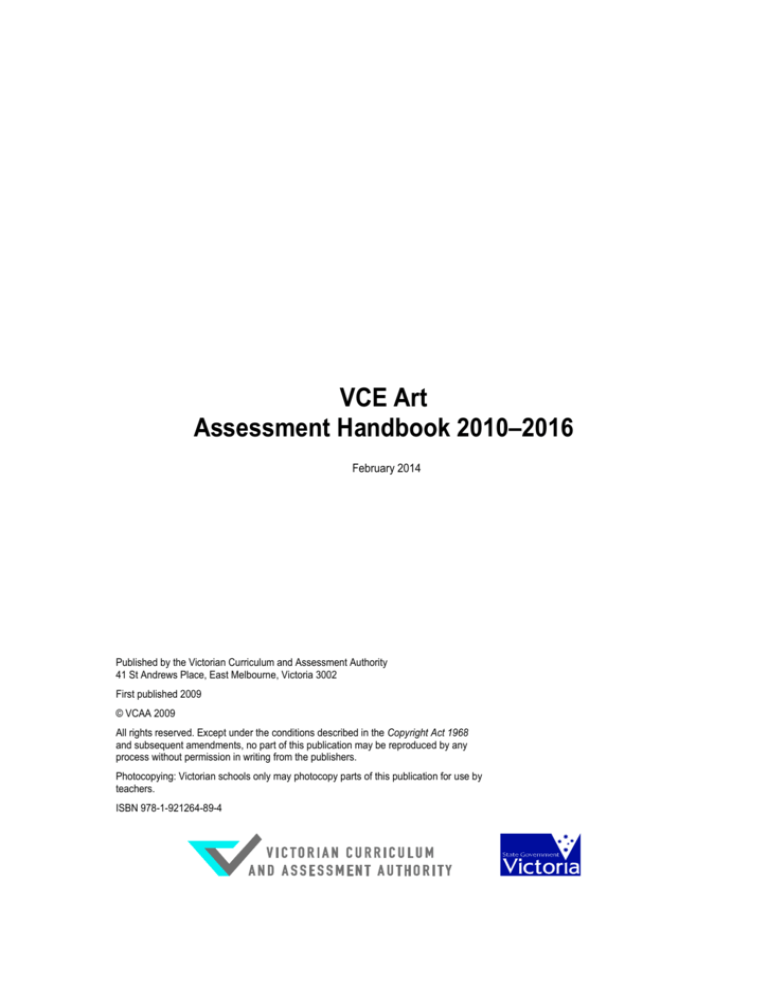
VCE Art
Assessment Handbook 2010–2016
February 2014
Published by the Victorian Curriculum and Assessment Authority
41 St Andrews Place, East Melbourne, Victoria 3002
First published 2009
© VCAA 2009
All rights reserved. Except under the conditions described in the Copyright Act 1968
and subsequent amendments, no part of this publication may be reproduced by any
process without permission in writing from the publishers.
Photocopying: Victorian schools only may photocopy parts of this publication for use by
teachers.
ISBN 978-1-921264-89-4
Contents
Introduction ..........................................................................................................................................3
Assessment ..........................................................................................................................................4
VCE assessment principles ........................................................................................................4
School-assessed Coursework ....................................................................................................6
Scope of tasks ....................................................................................................................7
Designing the assessment tasks ........................................................................................7
Making assessment part of teaching and learning .............................................................7
Art Assessment Advice and Further Resources ...............................................................................9
School-assessed Coursework ....................................................................................................9
Unit 3 Performance descriptors ..........................................................................................9
Unit 4 Performance descriptors ........................................................................................11
School-assessed Task .............................................................................................................13
Sample approaches to School-assessed Coursework .............................................................14
Unit 3 ................................................................................................................................14
Unit 4 ................................................................................................................................19
Further Resources ....................................................................................................................21
Examination ......................................................................................................................21
Publications ......................................................................................................................21
© VCAA February 2014
VCE Art
ASSESSMENT HANDBOOK 2010–2016
Introduction
The VCE Art Assessment Handbook 2010–2016 contains assessment information for
both school-based assessment and the examination in Art and advice for teachers on
how to construct assessment tasks. Advice on matters related to the administration of
VCE assessment is published annually in the VCE and VCAL Administrative
Handbook. Updates to matters related to the administration of VCE assessment is
published in the VCAA Bulletin VCE, VCAL and VET. Teachers must refer to these
publications for current advice.
Units 1 and 2
In Art the student’s level of achievement in Units 1 and 2 is a matter for school
decision. Assessment of levels of achievement for these units will not be reported to
the Victorian Curriculum and Assessment Authority (VCAA). Schools may choose to
report levels of achievement using grades, descriptive statements or other indicators.
Units 3 and 4
The VCAA will supervise the assessment of all students undertaking Units 3 and 4.
In Art the student’s level of achievement will be determined by School-assessed
Coursework, a School-assessed Task and an end-of-year examination. The VCAA will
report the student’s level of performance on each of three Graded Assessment
components: Units 3 and 4 School-assessed Coursework, Units 3 and 4 Schoolassessed Task and the end-of-year examination as a grade from A+ to E or UG
(ungraded).
This assessment handbook is published in online format only and provides advice
specifically for Units 3 and 4.
Updates to the online Assessment Handbook are published in the VCAA Bulletin
VCE, VCAL and VET.
Teachers are advised that there may be minor errors in the contents page due to
software version differences.
© VCAA February 2014
3
ASSESSMENT HANDBOOK 2010–2016
VCE Art
Assessment
VCE assessment principles
Assessment is an integral part of teaching and learning that, at the senior secondary
level:
identifies opportunities for further learning
describes student achievement
articulates and maintains standards
provides the basis for the award of a certificate.
As part of VCE studies, assessment tasks enable:
the demonstration of the achievement of an outcome or set of outcomes
judgment and reporting of a level of achievement on a task or collection of tasks
for School-assessed Coursework, School-assessed Tasks or examinations.
Monitoring the results of VCE assessment also provides feedback that informs
curriculum implementation, assessment design and curriculum review.
In each VCE study, teachers and schools determine the assessment tasks to be
used at Units 1 and 2. In Units 3 and 4, specified assessment tasks are set.
At the Units 3 and 4 level of a VCE study, School-assessed Coursework, Schoolassessed Tasks and examinations provide assessment results that are used in the
calculation of a student’s study score.
The following are the principles that underpin all VCE assessment practices. These
are extracted from the VCAA Principles and guidelines for the development and
review of VCE Studies.
VCE assessment will be valid
This means that it will enable judgments to be made about demonstration of the
outcomes and levels of achievement on assessment tasks fairly, in a balanced way
and without adverse effects on the curriculum or for the education system. The
overarching concept of validity is elaborated as follows.
VCE assessment should be fair and reasonable
Assessment should be acceptable to stakeholders – including students, schools,
government and the community. The system for assessing the progress and
achievement of students must be accessible, effective, equitable, reasonable and
transparent.
4
© VCAA: February 2014
VCE Art
ASSESSMENT HANDBOOK 2010–2016
Assessment instruments should not assess learning that is outside the scope of a
study design.
Each assessment instrument (for example, examination, assignment, test, project,
practical, oral, performance, portfolio, presentation or observational schedule) should
give students clear instructions. It should be administered under conditions (degree
of supervision, access to resources, notice and duration) that are substantially the
same for all students undertaking that assessment.
VCE assessment should be equitable
Assessment instruments should neither privilege nor disadvantage certain groups of
students or exclude others on the basis of gender, culture, linguistic background,
physical disability, socioeconomic status and geographical location.
Assessment instruments should be designed so that, under the same or similar
conditions, they provide consistent information about student performance. This may
be the case when, for example, alternatives are offered at the same time for
assessment of an outcome (which could be based on a choice of context) or at a
different time due to a student’s absence.
VCE assessment will be balanced
The set of assessment instruments used in a VCE study will be designed to provide a
range of opportunities for a student to demonstrate in different contexts and modes
the knowledge, skills, understanding and capacities set out in the curriculum. This
assessment will also provide the opportunity for students to demonstrate different
levels of achievement specified by suitable criteria, descriptors, rubrics or marking
schemes.
Judgment about student level of achievement should be based on the results from a
variety of practical and theoretical situations and contexts relevant to a study.
Students may be required to respond in written, oral, performance, product, folio,
multimedia or other suitable modes as applicable to the distinctive nature of a study
or group of related studies.
VCE assessment will be efficient
The minimum number of assessments for teachers and assessors to make a robust
judgment about each student’s progress and learning will be set out in the study
design. Each assessment instrument must balance the demands of precision with
those of efficiency. Assessment should not generate workload and/or stress that
unduly diminish the performance of students under fair and reasonable
circumstances.
© VCAA February 2014
5
ASSESSMENT HANDBOOK 2010–2016
VCE Art
School-assessed Coursework
School-assessed Coursework provides schools with the opportunity to make their
own administrative arrangements for the internal assessment of their students.
School-assessed Coursework also provides teachers with the opportunity to:
select from the range of designated assessment tasks in the study design
develop and administer their own assessment program for their students
monitor the progress and work of their students
provide important feedback to the student
gather information about the teaching program.
Students should know in advance how and when they are going to be assessed and
the conditions under which they will be assessed.
Assessment tasks should be part of the teaching and learning program. For each
assessment task students should be provided with the:
type of assessment task and approximate date for completion
time allowed for the task
allocation of marks
nature of any materials they can utilise when completing the task
opportunity to demonstrate the highest level of performance.
Following an assessment task:
teachers can use the performance of their students to evaluate the teaching and
learning program
a topic may need to be carefully revised again prior to the end of the unit to
ensure students fully understand the key knowledge and skills required in
preparation for the examination.
Feedback provides students with important advice about which aspect or aspects of
the key knowledge they need to learn and in which key skills they need more
practice.
Authentication
Teachers should have in place strategies for ensuring that work submitted for
assessment is the student’s own work. Where aspects of School-assessed
Coursework tasks are completed outside class time teachers must monitor and
record each student’s progress through to completion. This requires regular sightings
of the work by the teacher and the keeping of records.
The teacher may consider it appropriate to ask the student to demonstrate his/her
understanding of the task at the time of submission of the work. If any part or all of
the work cannot be authenticated, then the matter should be dealt with as a breach of
rules.
To reduce the possibility of authentication problems arising, or being difficult to
resolve, the following strategies are useful:
Ensure that a significant amount of classroom time is spent on the task so that
the teacher is familiar with each student’s work and can regularly monitor and
discuss aspects of the work with the student.
Ensure that students document the specific stages of the development of work,
starting with an early part of the task such as topic choice, list of resources
and/or preliminary research.
6
© VCAA: February 2014
VCE Art
ASSESSMENT HANDBOOK 2010–2016
Filing of copies of each students work at given stages in its development.
Regular rotation of topics from year to year to ensure that students are unable to
use student work from the previous year.
Where there is more than one class of a particular study in the school, the VCAA
expects the school to apply internal moderation/cross-marking procedures to
ensure consistency of assessment between teachers. Teachers are advised to
apply the same approach to authentication and record-keeping, as cross-marking
sometimes reveals possible breaches of authentication. Early liaison on topics,
and sharing of draft student work between teachers, enables earlier identification
of possible authentication problems and the implementation of appropriate
action.
Encourage students to acknowledge tutors, if they have them, and to discuss and
show the work done with tutors. Ideally, liaison between the class teacher and
the tutor can provide the maximum benefit for the student and ensure that the
tutor is aware of the authentication requirements. Similar advice applies if
students receive regular help from a family member.
Scope of tasks
Assessment tasks must be a part of the regular teaching and learning program and
must not unduly add to the workload associated with that program. They must be
completed mainly in class and within a limited timeframe. Where optional
assessment tasks are used, teachers must ensure that they are comparable in scope
and demand. Teachers should select a variety of assessment tasks for their program
to reflect the key knowledge and skills being assessed and to provide for different
learning styles.
Designing the assessment tasks
Designing an assessment task is an important part of the teaching, learning and
assessment process. The assessment task needs to provide the opportunity for all
students to demonstrate the highest level of performance on the outcome. Teachers
should design an assessment task that is representative of the content (key
knowledge and skills underpinning the outcome). Performance descriptors for each
outcome in Units 3 and 4 are provided to assist teachers in making a judgment about
the student’s level of performance on the outcome.
The following information presents one approach to developing an assessment task.
Making assessment part of teaching and learning
Step 1: Define the parameters of an outcome and its related assessment task
options
This involves:
Listing the key knowledge and skills that will be assessed by the outcome. These
are stated in the study design but you may wish to reword them for student
purposes.
Choosing the assessment task from the options listed in the study design. It is
possible for students in the same class to undertake different options; however,
teachers must ensure that the tasks are comparable in scope and demand.
Step 2: Examine the assessment advice
© VCAA February 2014
7
ASSESSMENT HANDBOOK 2010–2016
VCE Art
Examine the highest level of performance descriptors and clarify their meaning if you
are unsure. Use the study design as your reference point. Remember the
performance descriptors for each outcome identify the qualities or characteristics that
you are looking for in a student response. This helps in the development of the task.
It also helps clarify what needs to be taught as well as what needs to be included in
the assessment task. It will assist students in understanding the expectations of the
task.
Step 3: Determine teaching and learning activities
Identify the nature and sequence of teaching and learning activities to cover the key
knowledge and skills outlined in the study design. It is important that a variety of
learning opportunities are provided to cater for individual preferred learning styles.
(Refer to the ‘Advice for teachers’ section of the study design for some specific
examples of learning activities for each outcome.)
Step 4: Design the assessment task
Try to use a range of task types across Units 3 and 4.
The information in the stimulus should be relevant to the task and assist students
in their response.
Check that the instructions are clear. Are they complete and unambiguous?
Conditions for the task
It is important that students know what is expected of them in an assessment
task. This means providing students with advice about the outcome’s key
knowledge and skills to be assessed. This allows students to understand during
the teaching and learning stage what they are expected to know or do.
Students should be provided with the performance descriptors by which their
response will be assessed.
Students should be advised about the conditions under which they will be
expected to do the task.
Teachers can develop their own rules, consistent with school policies, about the
material that can be brought into the room and the use of textbooks. Make sure
that these rules are given to the students before the task is started and preferably
in writing.
One method of authentication is to collect the work at the end of each period and
keep it in an individual plastic folder or workbook.
Points to consider
When constructing a task you will need to consider the following:
Does the task enable students to demonstrate the highest possible performance
level?
Will students select the form of the response or will you select the form that the
whole class will use?
Will the task be completed in one lesson or over several lessons? If the task is
going to run over several lessons will you divide the task into parts or collect
students’ work at the end of each lesson? If your school has multiple Art classes
and your task is designed to last several lessons will you slightly alter the task for
each class?
Does the task allow you to easily identify the key aspects of the response to be
assessed?
8
© VCAA: February 2014
VCE Art
ASSESSMENT HANDBOOK 2010–2016
Art Assessment Advice and Further Resources
School-assessed Coursework
Teachers will provide to the Victorian Curriculum and Assessment Authority (VCAA)
a score for each outcome in each of Units 3 and 4, which represents an assessment
of the student’s achievement. The score must be based on the teacher’s assessment
of the level of performance of each student on the outcomes for the unit specified in
the study design. Teachers must select assessment tasks from the designated list for
each outcome published in the study design.
Assessment tasks should be a part of the regular teaching and learning program and
should not add unduly to student workload. Assessment tasks should be completed
mainly in class and within a limited timeframe. The overall assessment program for
the unit should include a variety of assessment task formats, include provision for
authentication of student work and take into account the overall workload for
students.
Performance descriptors
Performance descriptors provide holistic statements of achievement developed from
the outcome statement and its key knowledge and skills, as specified in the study
design. They provide guidance for the setting and marking of assessment tasks.
Unit 3
School-assessed Coursework for the outcomes in Unit 3 will contribute 10 per cent to
the student’s study score for Art.
Outcome 1
Use the Analytical Frameworks to analyse and interpret artworks produced before
1970 and artworks produced since 1970, and compare and contrast the meanings
and messages of artworks produced before 1970 with those of artworks produced
since 1970.
This outcome will contribute 30 marks for School-assessed Coursework for Unit 3. It
will be assessed by one or more tasks, which will contribute a total of 30 marks.
Task/s
Description
Any one or combination of the following:
a written report
an extended response
© VCAA February 2014
9
ASSESSMENT HANDBOOK 2010–2016
VCE Art
short responses
structured questions
an annotated visual report
a multimedia presentation.
Designing the assessment task
Teachers should develop an assessment task that allows the student to:
compare and contrast selected art works of at least one artist who has produced
work before 1970 with at least one other artist who has produced work since
1970
produce a detailed analysis of at least two artworks of each artist applying
relevant aspects of the Analytical Frameworks: the Formal, Personal, Cultural
and Contemporary
interpret meanings and messages of artworks produced before and since 1970
substantiate interpretations with detailed evidence from the artworks and a range
of resources
use art language and vocabulary
have the opportunity to demonstrate the highest level of performance.
Resources and scheduling
Schools may determine the conditions for the task including access to resources and
notes. Students should be advised of the timeline and conditions under which the
task is to be conducted.
Performance descriptors
The following descriptors provide a guide to the levels of performance typically
demonstrated within each range on the assessment task.
Outcome 1
Use the Analytical Frameworks to analyse and interpret artworks produced before
1970 and artworks produced since 1970, and compare and contrast the meanings
and messages of artworks produced before 1970 with those artworks produced
since 1970.
MARK RANGE
DESCRIPTOR: typical performance in each range
25–30 marks
Comprehensive and insightful analysis and perceptive
interpretation of artworks through the application of relevant
aspects of the Analytical Frameworks. Points of comparison
consistently and clearly integrated to establish relationships
between artists and artworks being compared. Wide range of
research resources used, and information clearly and effectively
referenced to artworks and artists. Highly effective use of
appropriate art language and vocabulary.
10
© VCAA: February 2014
VCE Art
ASSESSMENT HANDBOOK 2010–2016
19–24 marks
Thorough analysis and meaningful interpretation of artworks
through the application of relevant aspects of the Analytical
Frameworks. Points of comparison integrated to establish an
effective comparison between artists and artworks. Range of
research resources used, and information clearly and effectively
referenced to artworks and artists. Clear use of appropriate art
language and vocabulary.
13–18 marks
Some depth of analysis and clear interpretation of artworks
through the application of mostly relevant aspects of the Analytical
Frameworks. Some points of comparison integrated to establish
relationships between artists and artworks being compared. Some
resources used when referencing artworks and artists. General
accuracy in the use of art language and vocabulary.
7–12 marks
Limited analysis and interpretation of artworks through the
application of some aspects of the Analytical Frameworks. Limited
recognition of points of comparison. Limited use of research and
resources, with limited referencing of information to artworks and
artists. Limited application of art language and vocabulary.
1–6 marks
Little analysis and interpretation of how the Analytical Frameworks
can be used in the interpretation of artworks. Little evidence of
understanding of how artworks can be presented and compared.
Little evidence of research and resources used, with little and, at
times, no referencing of information to artworks and artists. Little
control of art language and vocabulary.
Unit 4
School-assessed Coursework for the outcomes in Unit 4 will contribute 10 per cent to
the student’s study score for Art.
Outcome 1
Discuss and debate an art issue using selected artist/s works as context, and present
their informed opinion with reference to artworks and with the support of selected
commentaries and relevant aspects of the Analytical Frameworks.
This outcome will contribute 30 marks for School-assessed Coursework for Unit 4. It
will be assessed by one or more tasks, which will contribute a total of 30 marks.
Task/s
Description
Any one or combination of the following:
a written report
an extended response
short responses
structured questions
an annotated visual report
a multimedia presentation.
Designing the assessment task
© VCAA February 2014
11
ASSESSMENT HANDBOOK 2010–2016
VCE Art
Teachers develop an assessment task that allows the student to:
discuss and debate an art issue
use a range of resources in the discussion to analyse and interpret artworks
through the application of relevant aspects of Analytical Frameworks.
refer to a range of commentaries that support or challenge a point of view
present personal opinions in reference to artists and artworks informed by
commentaries
use appropriate art language and vocabulary
have the opportunity to demonstrate the highest level of performance.
Resources and scheduling
Schools may determine the conditions for the task including access to resources and
notes. Students should be advised of the timeline and conditions under which the
task is to be conducted.
Performance descriptors
The following descriptors provide a guide to the levels of performance typically
demonstrated within each range on the assessment task.
Outcome 1
Discuss and debate an art issue using selected artist/s works as context, and
present their informed opinion with reference to artworks and with the support of
selected commentaries and relevant aspects of the Analytical Frameworks.
MARK RANGE
DESCRIPTOR: typical performance in each range
25–30 marks
Critical and comprehensive understanding of an art issue
supported by well-selected commentaries, supported through
comprehensive application of relevant aspects of the Analytical
Frameworks. Clearly integrated points of comparison, evaluating
interpretations and differing viewpoints. Effective use of
appropriate art language and vocabulary.
19–24 marks
Well-developed understanding of an art issue supported by
selected commentaries, supported through the detailed application
of relevant aspects of the Analytical Frameworks. Integrated points
of comparison with relevant evaluation and interpretation of
differing viewpoints. Accurate use of appropriate art language and
vocabulary.
13–18 marks
General understanding of an art issue supported by some
commentaries, supported by the application of aspects of the
Analytical Frameworks. Integrates some points of comparison,
with some evaluation and interpretation of differing viewpoints.
Largely accurate use of some appropriate art language and
vocabulary.
7–12 marks
Limited understanding of an art issue supported by some
commentaries, supported by some understanding of the
application of aspects of the Analytical Frameworks. Limited
integration of points of comparison of the differing viewpoints
identified in the commentaries. Limited use of appropriate art
language and vocabulary.
12
© VCAA: February 2014
VCE Art
1–6 marks
ASSESSMENT HANDBOOK 2010–2016
Little reference to and understanding of an art issue supported by
commentaries, supported by little understanding of the application
of aspects of the Analytical Frameworks. Points of comparison are
rarely integrated. Very little referencing of information. Little
understanding of the use of art language and vocabulary.
School-assessed Task
Units 3 and 4
The School-assessed Task contributes 50 per cent to the study score and is
commenced in Unit 3 and completed in Unit 4.
Outcomes
Unit 3
Outcome 2
Explore personal ideas and concepts
through a conceptual and practical
investigation including at least one finished
artwork, using selected Analytical
Frameworks to reflect upon and annotate
their work.
Unit 4
Outcome 2
Progressively communicated ideas,
directions and/or personal concepts in a
body of work that includes at least one
finished artwork, having used selected
Analytical Frameworks to underpin
reflections on their artmaking.
School-assessed Task
Subject to
external review
A body of work representing explorations within selected
art form/s and/or media which clearly demonstrates the
development of the student’s thinking and working
practices. The progressive realisation and resolution of
the body of work reflects personal concepts, ideas,
directions, explorations, aesthetic qualities and technical
skills, with at least two finished artworks that resolve the
student’s intentions.
Teachers will provide to the Victorian Curriculum and Assessment Authority (VCAA)
a single score representing an assessment of the student’s level of performance in
achieving Outcome 2 in Unit 3 and Outcome 2 in Unit 4. The score must be based
on the teacher’s assessment of the student’s performance according to the
criteria published each year on the Art study page on the VCAA website. The
set of criteria for the award of grades is the sole basis for the assessment of Schoolassessed Tasks. The completed assessment sheet for each student’s Schoolassessed Task must be available on request by the VCAA.
Details of authentication requirements and administrative arrangements for the
School-assessed Task will be published annually on the Art study page and the
current year’s VCE and VCAL Administrative Handbook.
© VCAA February 2014
13
ASSESSMENT HANDBOOK 2010–2016
VCE Art
Sample approaches to School-assessed Coursework
The following examples are one teacher’s approach to the development of
assessment tasks using the study design and performance descriptors.
The VCAA does not endorse any individual gallery or artist.
Unit 3
Outcome 1
Use the Analytical Frameworks to analyse and interpret artworks produced before
1970 and artworks produced since 1970, and compare and contrast the meanings
and messages of artworks produced before 1970 with those of artworks produced
since 1970.
Pre-task knowledge
Before commencing this assessment task, a student should be familiar with all the
Analytical Frameworks (Formal, Personal, Cultural and Contemporary Frameworks).
In addition students should have:
Studied at least one artist who produced work before 1970 and at least one other
artist who produced work since 1970.
Studied at least two artworks of each of the chosen artists.
Compared and contrasted the artworks of selected artists who produced before
1970 and those who produced since 1970.
Applied relevant aspects of all Analytical Frameworks across each of the selected
artworks to interpret the meanings and messages.
How to teach the pre-task knowledge
One approach is to introduce each of the Analytical Frameworks to the class and
discuss examples of each with reference to specific artworks. The selection of
relevant questions to support discussions can be drawn from the questions listed
on pages12–14 in the VCE Art Study Design. The lessons in the introduction
could be based on class discussion of specific reading material or the students
may assist in the construction of wiki pages or blog discussions in which artworks
are provided for each student to analyse using the Analytical Frameworks.
– The development of a sound art language may be enhanced by reading and
highlighting appropriate sentences from art reviews taken from the daily
papers, art journals or/and gallery support materials.
– Teachers may devote a specific lesson to each of the four Analytical
Frameworks as part of the regular teaching program where students discuss
evidence of the Analytical Frameworks in each artwork or draw diagrams of
the artworks and use graphic diagrams to refer to specific parts of the artwork
to support their own point of view.
– Websites focusing on specific artists may be used, for example:
www.tomphillips.co.uk/index.html
www.ngv.vic.gov.au/ngvschools/TraditionAndTransformation/artists/JulieDowling/
A series of questions can be provided for students when research and class
discussions or debates are conducted on the meanings and messages of
selected artists and their artworks.
14
© VCAA: February 2014
VCE Art
ASSESSMENT HANDBOOK 2010–2016
Attention should be given to comparing and contrasting artists and artworks made
before and since 1970. These lessons would use a common set of artworks to
discuss differences and similarities between them. Reference to their meanings
and messages as understood through the application of the Analytical
Frameworks should be made.
After an introductory session several options are possible
– the class covers all the Analytical Frameworks, artists and artworks with
students completing research on selected artists or with all students in the
class comparing and contrasting the same artworks;
– individual students could study artists and artworks related to their folio work
and apply the Analytical Frameworks covered by the class. Here individual
research would be a more significant component of the work done for this
outcome. In this option students should be advised in their selection of
artworks so that meaningful comparisons and contrasts can be completed
and all Analytical Frameworks referenced;
– as some artworks are more conducive to analysis from the perspective of
particular Analytical Frameworks students should be made aware of using the
relevant aspects of each framework as they complete each analysis. Equally,
more resources may be available about some artworks with reference to
some Analytical Frameworks than other frameworks.
In all these options teachers should monitor student research to ensure that the
appropriate aspects of all four Analytical Frameworks are being applied to
artworks produced before and since 1970.
In the following examples relevant aspects of all four Analytical Frameworks (Formal,
Personal, Cultural and Contemporary) are applied for each artwork. Detailed
explanations of the four Analytical Frameworks can be found on pages 12–14 of the
VCE Art Study Design 2010–2016.
Details of the task
Any one or combination of the following assessment tasks may be chosen
a written report
an extended response
short responses
structured questions
an annotated visual report
a multimedia presentation.
© VCAA February 2014
15
ASSESSMENT HANDBOOK 2010–2016
VCE Art
Unit 3, Outcome 1
Example A
Task: Create a multimedia presentation using relevant aspects of the Analytical
Frameworks, to compare and contrast the following artists and artworks.
Examples of artworks before 1970
Artist and artworks
Analytical Frameworks
Mary Cassatt (USA &
France, 1844–1926)
‘The Bath’, 1892
Personal Analytical framework:
Cassatt often used members of her
family as models to depict the daily
lives of women in the late 1800s.
Cultural Analytical Framework: The
invention of the camera meant that candid
scenes were often captured. Cassatt was
also influenced by the Japanese prints that
were on display in Paris in the 1890s.
‘Mother Combing her
Child’s Hair’,
c. 1901
Formal Framework: This image is
closely cropped and uses shallow
space to invite the audience into this
personal event.
Contemporary Analytical Framework: From
the perspective of today do you think
Cassatt was an early feminist? Was she a
radical in using very bold pastel techniques
at this time?
Examples of artworks since 1970
Artist and artworks
Analytical Frameworks
Stewart MacFarlane
(Australia, b.1953)
‘The Boarder’, 1987
Personal Analytical framework:
MacFarlane works directly from life
and sees himself as a filmmaker or
storyteller.
Cultural Analytical Framework: MacFarlane
worked in New York for several years and was
influenced by the film-maker Alfred Hitchcock
as he attempted to create a feeling of drama in
each of his paintings.
‘Strangers’, 1988
Formal Framework: Macfarlane
worked as an artist’s assistant in
New York where he developed the
technique of painting directly from
life. Often colours are rich and
forms are highlighted with dramatic
lighting using bold brush strokes.
Contemporary Analytical Framework:
Macfarlane confronts the viewer with his
tension filled scenes that are often depicting
violence or sexuality which challenges the
viewer to interpret the ‘story’ unfolding before
their eyes.
Resources
Pollock, Griselda 1996, Mary Cassatt: An American Impressionist, Todtri, New York.
Williams, Donald and Simpson, Colin 1996, ‘Art Now, Contemporary Art Post 1970’, McGraw-Hill, Sydney.
16
© VCAA: February 2014
VCE Art
ASSESSMENT HANDBOOK 2010–2016
Example B
Use relevant aspects of the Analytical Frameworks to produce a written report that
compares and contrasts the meanings and messages of the following artists and
artworks.
Examples of artworks before 1970
Artist and artworks
Analytical Frameworks
Margaret Preston
(Australian, 1875–
1963)
‘Wheel Flowers’, 1929
Formal Framework: this image is an
open composition with strong linear
designs created through woodblock printing technique. The colour
is hot and tropical, the composition
chaotic and decorative with a sense
of movement. This technique
assists in the creation of patterns
and colour which are reminiscent of
Australian indigenous art.
Cultural Analytical Framework: Preston
travelled to London and Paris to study the work
of European artists and was influenced by
decorative concepts. She was interested in
creating distinctively Australian art and found
inspiration in Australian indigenous imagery.
Indigenous content was often the basis of her
lectures and articles.
‘Kangaroo Hunt’, 1949
Personal Analytical framework:
Preston was able to travel around
Australia in small planes in the
1940s. She also travelled to Japan
to study the wood-block techniques
of the famous artist Hiroshige.
Contemporary Analytical Framework: Was
Preston ahead of her time because of her love
of purely Australian images and the indigenous
culture? How is her appropriation of
indigenous images perceived today?
Examples of artworks since 1970
Artist and artworks
Analytical Frameworks
Masami Teraoka
(Japan, USA b.1936)
‘Longing Samurai,
from Hawaii Snorkel
series’, 1993
Personal Analytical framework:
Teraoka moved to USA where he
felt like a stranger unable to
communicate; this image shows a
young punk Japanese man wanting
to talk to the blond westerner.
Cultural Analytical Framework: Teraoka
embraced Pop Art and American movies. He
also visited Honolulu on the island of Hawaii
where he saw tourists from Japan and the US
spending quick visits to absorb this new
culture.
‘McDonalds
Hamburgers Invading
Japan/Flying Fries’
1974
Formal Framework: Teraoke works
with watercolours as well as woodblock techniques which reflect the
use of traditional calligraphic lines
and flat areas of colour.
Contemporary Analytical Framework:
Teraoka’s work is full of wit and humour
showing contemporary scenes, while still using
the traditional printmaking techniques of
Japanese printmakers.
Resources
Chamberlin, Lou 2007, ‘Art in Sight’, McGraw-Hill, Sydney.
Edwards, Deborah 2005, ‘Margaret Preston’ catalogue, Art Gallery NSW.
Williams, Donald and Simpson, Colin 1996, ‘Art Now, Contemporary Art Post 1970’, McGraw-Hill, Sydney.
© VCAA February 2014
17
ASSESSMENT HANDBOOK 2010–2016
VCE Art
Example C
Use relevant aspects of the Analytical Frameworks to compare and contrast the
meanings and messages of the following artists and artworks in an extended
response.
Examples of artworks before 1970
Artist and artworks
Analytical Frameworks
Charles Summers,
(Australian, 1830–
1878)
‘Burke and Wills’, 1865
Formal Framework: This large
bronze cast shows a strong
triangular composition that unifies
the two figures. Is there evidence of
the original clay structure shown in
the bronze cast?
Cultural Analytical Framework: Summers
attempted to find gold on the Victorian gold
fields before accepting a commission to
decorate the new Victorian Parliament house.
Summers had a studio in Collins Street,
Melbourne where he allowed new young artists
to exhibit their work.
‘Queen Victoria’, 1878
Personal Analytical framework:
Summers was influenced by the
work of Michelangelo, so he used
similar formal compositions. He was
also commissioned to create many
pieces for the Victorian Government
in the 1860s.
Contemporary Analytical Framework: Is this
sculpture relevant in the twenty-first century?
Is the site of this work important for interaction
with the public? Do the figures created by
Summers symbolise the explorers as heroes?
Examples of artworks since 1970
Artist and artworks
Analytical Frameworks
Lui Ji (Ah) Xian (China,
Australia b.1960)
‘Dr John Yu AC,
Canberra’, 2003–2004
Cultural Analytical framework: Ah
Xian moved to Australia following
his protests (and imprisonment)
following the Tian’anmen Square
violence in 1989. He attempts to
link his traditional past life in China
with his new life.
Personal Analytical Framework: The portrait
busts that he creates always have their eyes
closed as a reference to his Chinese friends.
Ah Xian attempts to link his traditional past life
in China with his new life.
‘China China-Bust 19’,
1999
Formal Framework: Ah Xian takes
plaster casts from figures of his
family and friends before creating a
porcelain cast which is hand
painted using traditional Chinese
decorative patterns.
Contemporary Analytical Framework: This
traditional portrait bust is painted in traditional
motifs generally used for painting plates etc.
Does it symbolise his culture, embedded like a
tattoo all over his body?
Resources
Hoffert, Bernard, Wingate, James, Bak, Henk and Modesti, Adelina 1995, Art in Diversity, Longman, Australia.
Roberts, Claire 2006, ‘The Slow Art of Ah Xian’, Art and Australia, Vol. 43, No. 3.
18
© VCAA: February 2014
VCE Art
ASSESSMENT HANDBOOK 2010–2016
Unit 4 Outcome 1
Discuss and debate an art issue using selected artist/s works as context, and
present their informed opinion with reference to artworks and with the support of
selected commentaries and relevant aspects of the Analytical Frameworks.
Example
Students discuss and debate the following issue in relation to the work of Barbara
Kruger, including their own viewpoints and making reference to at least two
artworks and commentaries.
‘That the value of art lies in its capacity to challenge and confront our thinking and
interaction with the world, and not in its aesthetic appeal.’
Questions to start discussions:
How does art inform and what does it inform us of?
Should art make us think and question?
Do we need to change our thinking?
How do we define ‘aesthetic appeal’ in relation to Barbara Kruger’s work?
Further discussion questions can be applied to specific artworks to support debate,
for example:
What questions does Kruger’s work pose?
What value do these questions provide for a contemporary western and/or
world audience?
What techniques does Kruger employ to invite the view to question?
How does the placement of Kruger’s art support contemplation or response?
Artist and artworks
Analytical Frameworks
Barbara Kruger (USA
b.1945)
‘Your body is a
Battleground’, 1989
Cultural Analytical framework:
Feminism in art was prominent in
the 1970s and 1980s and reflected
aspects of American feminist
culture of the time. Kruger is
interested in how women are
portrayed in the media. Kruger sees
frequent images in film, TV and
many artworks as being directed to
a male spectator. Her work aims to
highlight and redress the
imbalance.
© VCAA February 2014
Personal Analytical Framework: Kruger
identifies the most prominent influence on her
work both visually and formally as her years as
a graphic designer-working with serialised
exercises with words and pictures. Kruger’s
graphic signature style is evident with large
black slogans often set against blocks of red
colour which are reminiscent of advertising,
newspapers and magazines.
19
ASSESSMENT HANDBOOK 2010–2016
‘Untitled (You Invest in
the Divinity of the
Masterpiece)’, 1982
Formal Framework: Kruger breaks
down original black and white
photographs or photocopies,
placing words and text in slogans
across the surface often slashing
through the image. The composition
reflects the advertising media,
implying that the viewer is being
‘sold’ something.
VCE Art
Contemporary Analytical Framework: Kruger
appropriates part of Michelangelo’s Sistine
Chapel ceiling; where God creates man
through a touch of his finger. Employing a
colourless reproduction of this section of the
image combined with text, she creates a
parallel between the Biblical creation story and
that of the highly praised masterpiece of
Western painting. What is she proposing about
the parallels of art and religion, money and
permanence? What is the significance of the
word ‘You’? What might be the links between
patriarchy of religion and art history?
Resources
Williams, Donald and Simpson, Colin 1996, ‘Art Now, Contemporary Art Post 1970’, McGraw-Hill, Sydney.
MOMA publication excerpt – What is Painting? Contemporary Art from the Collection, July 7–September 17,
2007 www.moma.org
20
© VCAA: February 2014
VCE Art
ASSESSMENT HANDBOOK 2010–2016
Further Resources
Examination
Description
The examination will be set by a panel appointed by the Victorian Curriculum and
Assessment Authority. Students will answer a series of questions based on Outcome
1 in Unit 3 and Outcome 1 in Unit 4.
Conditions
The examination will be completed under the following conditions:
Duration: one and a half hours.
Date: end-of-year, on a date to be published annually by the Victorian Curriculum
and Assessment Authority.
Victorian Curriculum and Assessment Authority examination rules will apply.
Details of these rules are published annually in the VCE and VCAL:
Administrative Handbook.
The examination will be marked by assessors appointed by the Victorian
Curriculum and Assessment Authority.
Contribution to final assessment
The examination will contribute 30 per cent.
Further advice
The Victorian Curriculum and Assessment Authority publishes specifications for all
VCE examinations on the Victorian Curriculum and Assessment Authority website.
Examination specifications include details about the sections of the examination, their
weighting, the question format/s and any other essential information. The
specifications are published in the first year of implementation of the revised Units 3
and 4 sequence together with any sample materials.
Publications
Regular updates and study advice are published in the VCAA Bulletin VCE, VCAL
and VET and on the VCAA website. Teachers should also refer to the following
publications for assessment of VCE Art:
VCE Art Study Design 2010–2016
The course developed and delivered to students must be in accordance with the VCE
Art Study Design, accredited 2010–2016.
The ‘Advice for teachers’ section contains sample learning activities for Units 1 to 4 and
suggested tasks.
VCAA website
Teachers are advised to keep up-to-date with developments in VCE Art by accessing the
Art study page on the VCAA website.
© VCAA February 2014
21
ASSESSMENT HANDBOOK 2010–2016
VCE Art
VCE Examination Papers
Examination papers for all studies are published on the VCAA website.
Assessment Reports
The Assessment Reports are published on the VCAA website and provide teachers
with an overview of the Examination for Units 3 and 4.
VCE Examination Papers
Examination papers for all studies are published on the VCAA website.
Assessment Reports
The Assessment Reports are published on the VCAA website and provide teachers
with feedback of the Examination for Units 3 and 4.
22
© VCAA: February 2014

